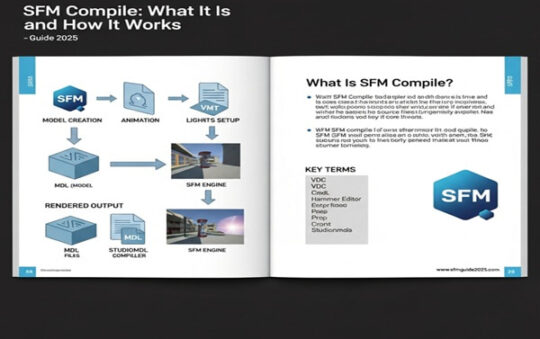Imagine holding a prism up to sunlight—watching it scatter beams of color across the room. That’s what Prizmatem does for innovation. It takes complex ideas and breaks them into bright, usable pieces that anyone—from designers to teachers to engineers—can shape into something amazing.
If you’re wondering what exactly Prizmatem is, how it works, or why it’s suddenly a buzzword among creative professionals and tech enthusiasts, you’re in the right place. Let’s explore what makes it such a fascinating and practical framework for modern creators.
Contents
What Is Prizmatem?
At its heart, Prizmatem blends creativity, technology, and design into one adaptable system. It’s not a single app or tool—it’s a mindset and a modular framework that helps people simplify complexity.
Think of it as a “build-your-own” system for innovation. Whether you’re creating interactive apps, designing optical materials, or building hands-on learning experiences, Prizmatem gives you the flexibility to construct solutions piece by piece.
Each “module” or “block” fits neatly into a bigger picture, allowing you to:
-
Experiment faster
-
Reuse components
-
Adjust quickly without starting from scratch
This structure makes Prizmatem a game-changer for fields like digital design, education, and materials engineering.
The Meaning Behind the Name
The word Prizmatem comes from “prism” + “pattern” + “tem” (a nod to “template” or “temporal”). It describes how large ideas can be split into smaller, patterned modules that evolve over time.
The concept took off in the early 2020s within creative tech communities, especially among digital designers and educators exploring modular systems. The prism metaphor fits perfectly—it’s all about refracting complexity into something you can actually see, use, and build on.
How People Are Using Prizmatem
Prizmatem isn’t confined to one space. It’s being adopted across industries, each using it in unique ways. Here’s how it shows up in practice:
1. Digital & Creative Tools
Designers use Prizmatem-like systems to build modular templates—color palettes, layout blocks, or animations—that can be rearranged like digital LEGO. Need a landing page, portfolio, or social campaign? Just plug in the modules you need.
2. Optics & Materials Science
Engineers have applied the Prizmatem idea to materials that bend or shape light. These “optical modules” improve solar panels, lenses, or architectural glass by layering light-manipulating components that function together.
3. Education & Business Training
Teachers and trainers love its adaptability. Lessons can be built in modules—like “Introduction,” “Quiz,” or “Hands-on Activity.” Learners move through at their own pace, while educators easily update individual pieces without redoing the whole course.
Why Prizmatem Works So Well
The magic lies in its modular architecture—every part operates independently but fits into a bigger system. Here’s what makes it stand out:
-
Scalable & Flexible: Add or remove parts without breaking the whole structure.
-
Reusable: Build once, reuse endlessly across projects.
-
Customizable: Change the look, content, or interaction style to match your vision.
-
Collaborative: Multiple people can build and combine their own modules.
-
Efficient: Less time spent starting over, more time spent improving results.
Whether it’s digital tools, physical materials, or educational resources, the same principles apply—structure, flexibility, and evolution.
Real-World Examples of Prizmatem in Action
Let’s see how different people and industries are applying the Prizmatem mindset:
Design Teams
A branding agency uses modular logo templates and typography blocks to quickly roll out campaigns for multiple clients. Each design looks unique, yet everything stays on-brand.
Teachers
A science teacher builds lessons as modular units: “Photosynthesis Basics,” “Experiment,” “Quiz.” Students learn in the order that fits their pace, and the teacher updates one module without touching the rest.
Product Developers
A company layering prism-inspired materials creates devices with improved light transmission—resulting in brighter screens and more efficient solar panels.
Sustainability Innovators
An eco-architecture firm uses modular panels that channel sunlight into buildings, cutting energy use while enhancing natural lighting.
What the Numbers Say
Even though Prizmatem is still emerging, early adopters are already seeing results:
-
A European design firm using modular workflows cut project time by 30%.
-
An online education platform boosted student completion rates by 25% after switching to module-based lessons.
-
Optical engineers saw 12% higher solar efficiency when layering modular light-reflecting composites.
The pattern is clear—structured creativity equals measurable performance.
How to Get Started with Prizmatem
Here’s how you can integrate Prizmatem thinking into your work—no matter your field.
For Designers & Developers
Use tools like Figma, Notion, or React to create reusable blocks—buttons, layouts, components. Over time, you’ll build a personal design library that saves hours of repetitive work.
For Teachers & Educators
Break lessons into small, independent units. Use platforms such as Moodle or Google Classroom to organize them into flexible learning paths.
For Engineers & Makers
Experiment with layered materials in design software. Try combining optical layers or 3D-printed components that interact dynamically.
For Teams
Build a shared library of modules and name them consistently (like “lesson-v1” or “widget-header-dark”). Schedule check-ins to ensure version control and quality remain high.
Also Read : Milyom The Viral Mystery Word You Need to Know
Common Challenges (and How to Fix Them)
Every powerful system has its quirks. Here are a few common hurdles—and how to overcome them.
-
Too Many Modules: Keep things organized. Use naming conventions and regular clean-ups.
-
Performance Lag: Limit how many modules load at once to maintain speed.
-
Team Confusion: Create a quick-start guide or internal wiki explaining how each module fits together.
-
Initial Learning Curve: Start small—master one section, then expand.
Prizmatem Compared to Other Systems
| Concept | Focus | How Prizmatem Differs |
|---|---|---|
| Modular Design Systems | UI/UX templates | Prizmatem applies modularity beyond design—to teaching, engineering, and art. |
| Design Thinking | Problem-solving & empathy | Adds a reusable structure for faster iteration. |
| Template Frameworks | Predefined layouts | Encourages mixing and evolving modules over time. |
| Minimalism & Authenticity | Simplicity | Focuses on adaptability and structure, not just reduction. |
The Future of Prizmatem
The next evolution of Prizmatem is already taking shape. Here’s what’s on the horizon:
-
AI-Generated Modules: Imagine sketching a button or component, and AI instantly creating it as a usable module.
-
Adaptive Optical Materials: Smart prisms that adjust color or transparency automatically.
-
Augmented Reality Learning: AR modules that appear when students reach specific milestones or locations.
-
Eco-Adaptive Design: Prizmatem-based solar panels or window coatings that shift with the seasons.
As technology continues to advance, Prizmatem’s modular philosophy will only grow more powerful—helping creators design smarter, faster, and greener.
FAQs About Prizmatem
Q1: Is Prizmatem a tool or an idea?
It’s more of a framework—a way of thinking that guides how you structure projects, lessons, or materials.
Q2: Who benefits most from it?
Designers, educators, product developers, and innovators who regularly reuse and adapt elements in their work.
Q3: Do I need expensive tools to start?
Not at all. You can apply Prizmatem principles using free software or even basic templates—the key is reusability and structure.
Q4: What are common mistakes to avoid?
Overcomplicating modules, skipping version control, or forcing modular design in places that need fluid creativity.
Final Thoughts
Prizmatem is more than a concept—it’s a bridge between creativity and structure. By breaking complexity into reusable pieces, it helps individuals and teams move faster, think smarter, and build better.
Whether you’re teaching a class, coding an app, or experimenting with light, Prizmatem offers a way to see your work through a new lens—literally and metaphorically.
Start with one small module, refine it, and expand from there. Like a prism revealing hidden colors, Prizmatem has the power to illuminate endless creative possibilities.




